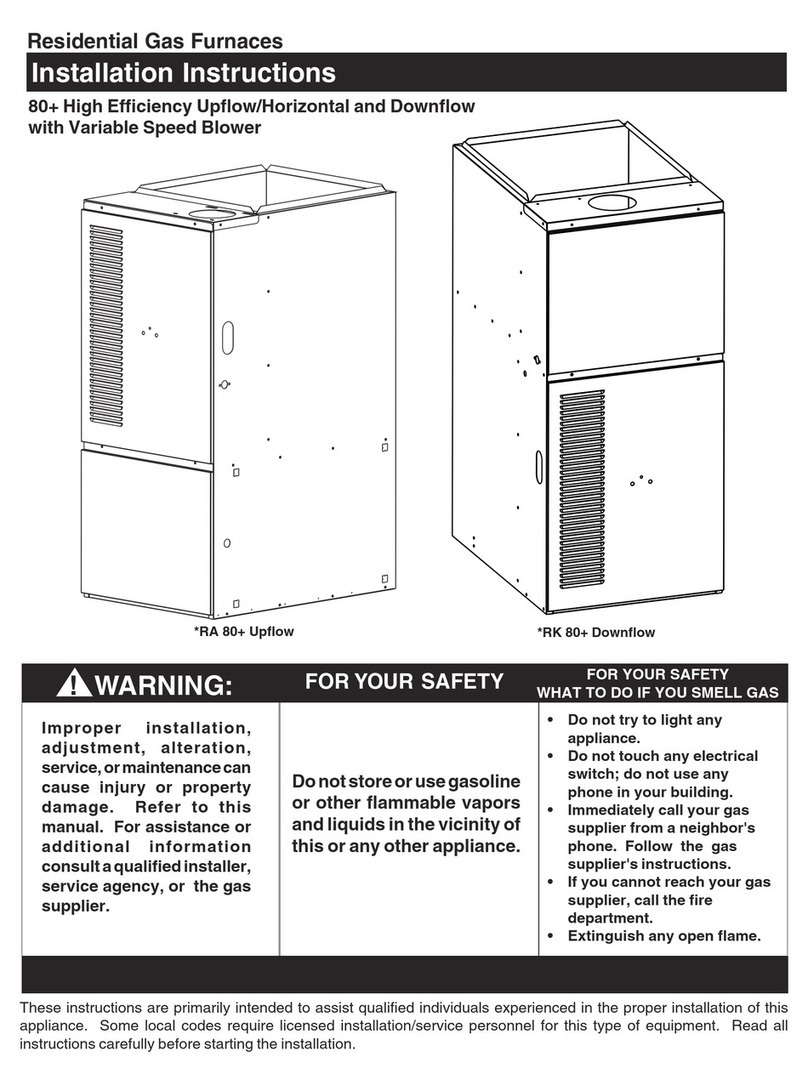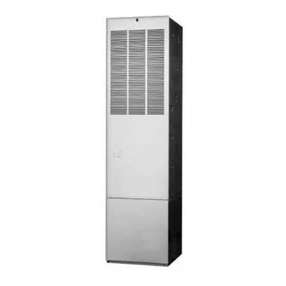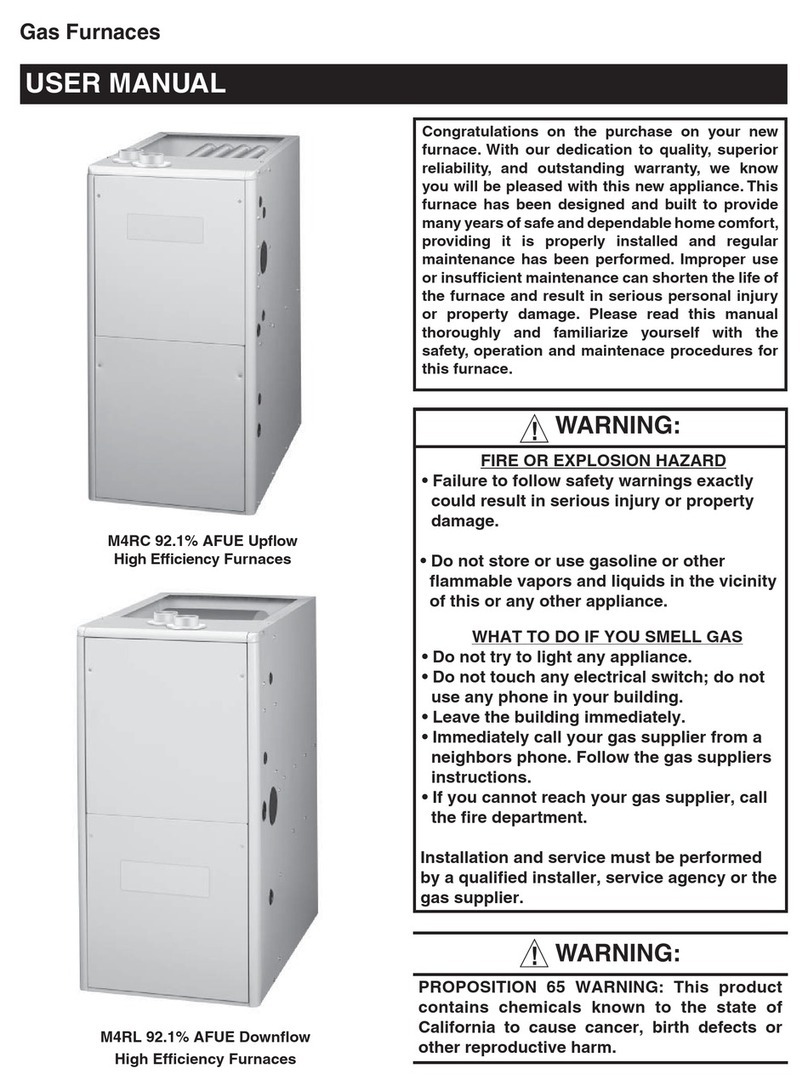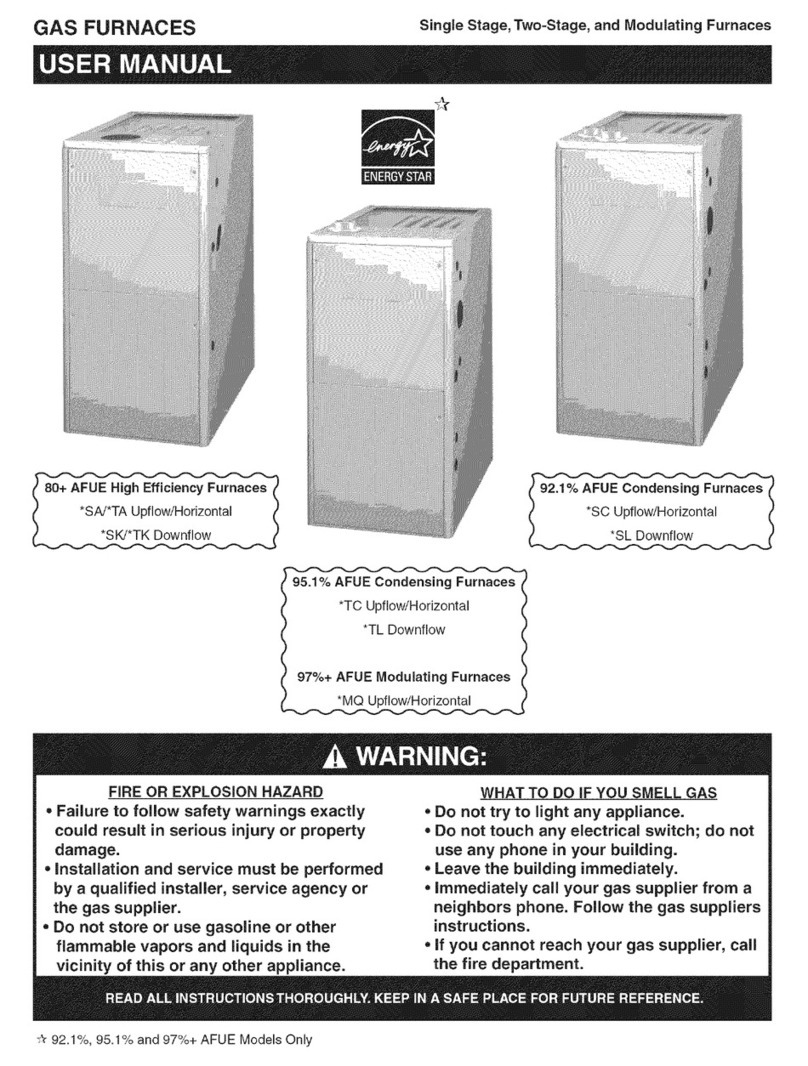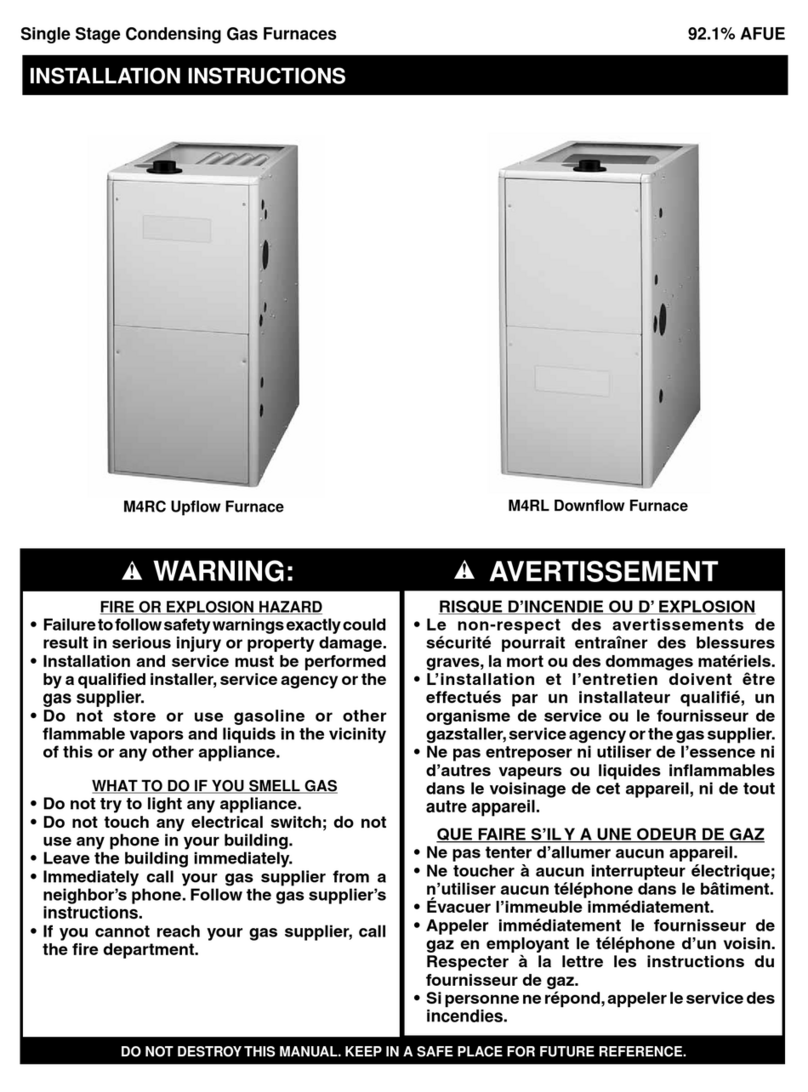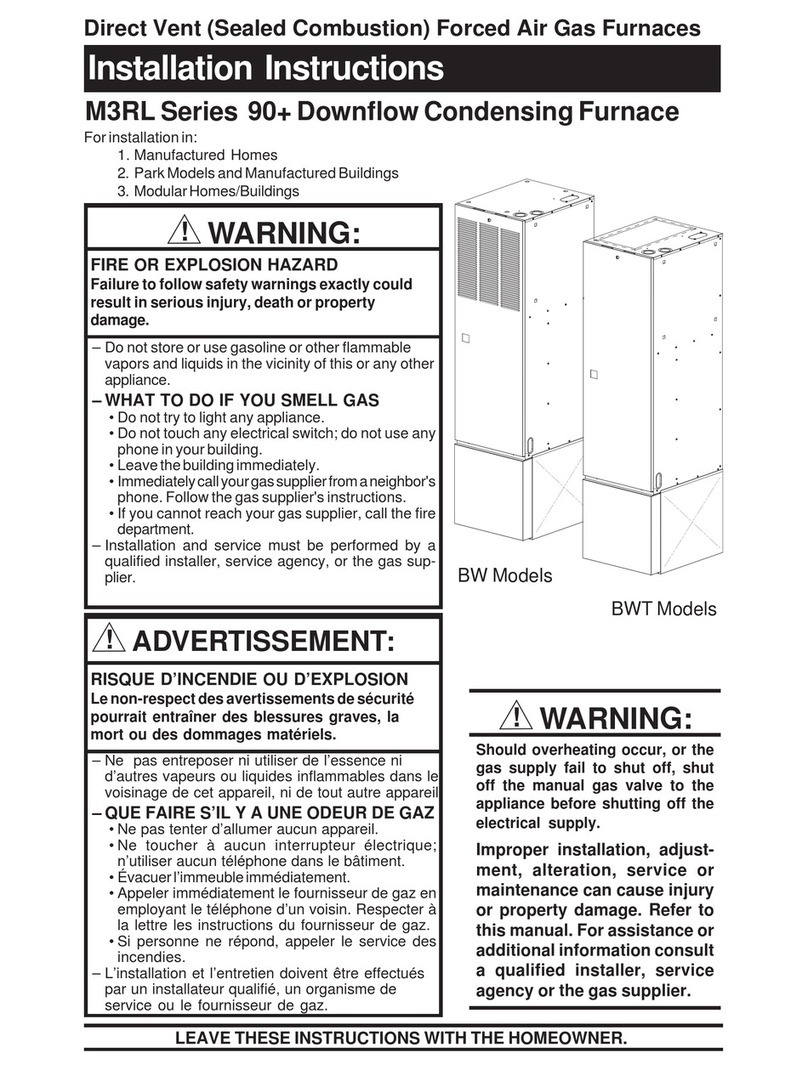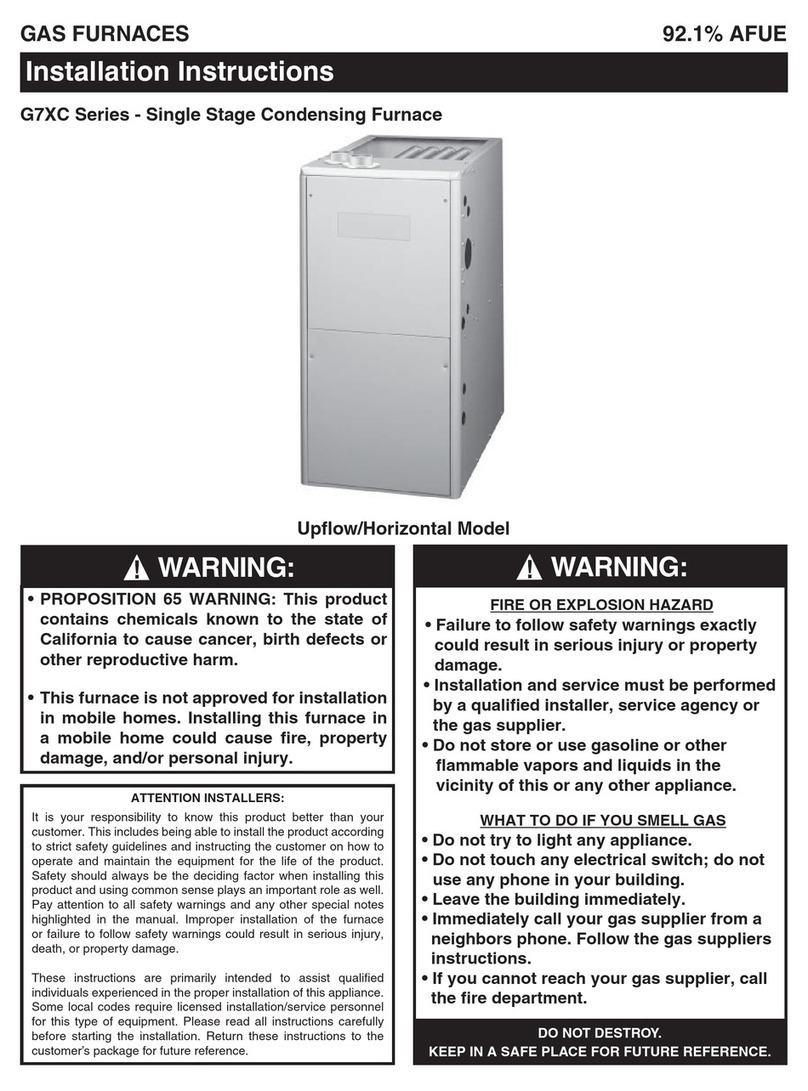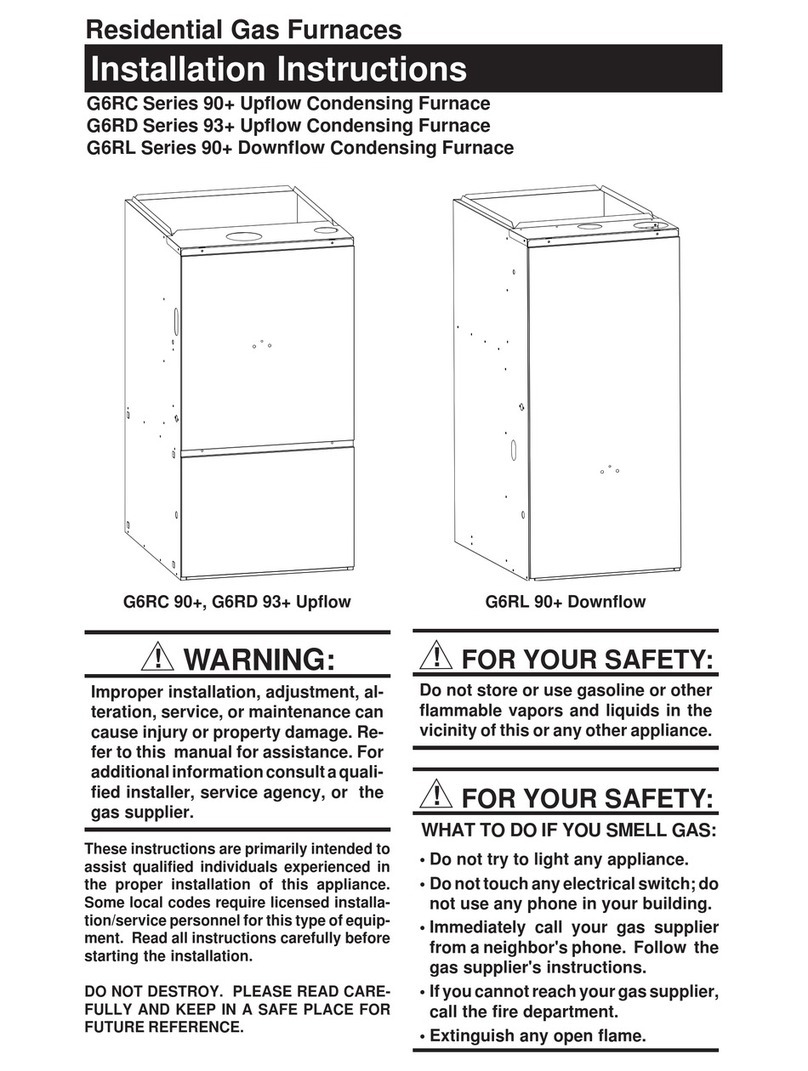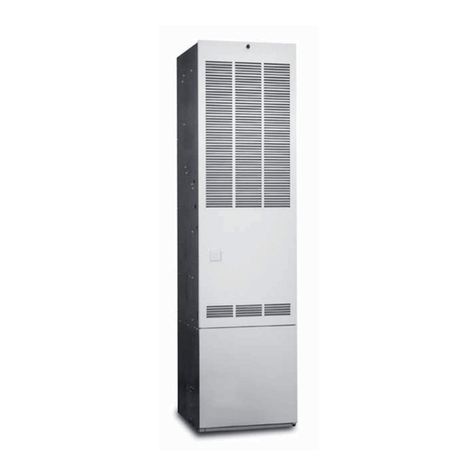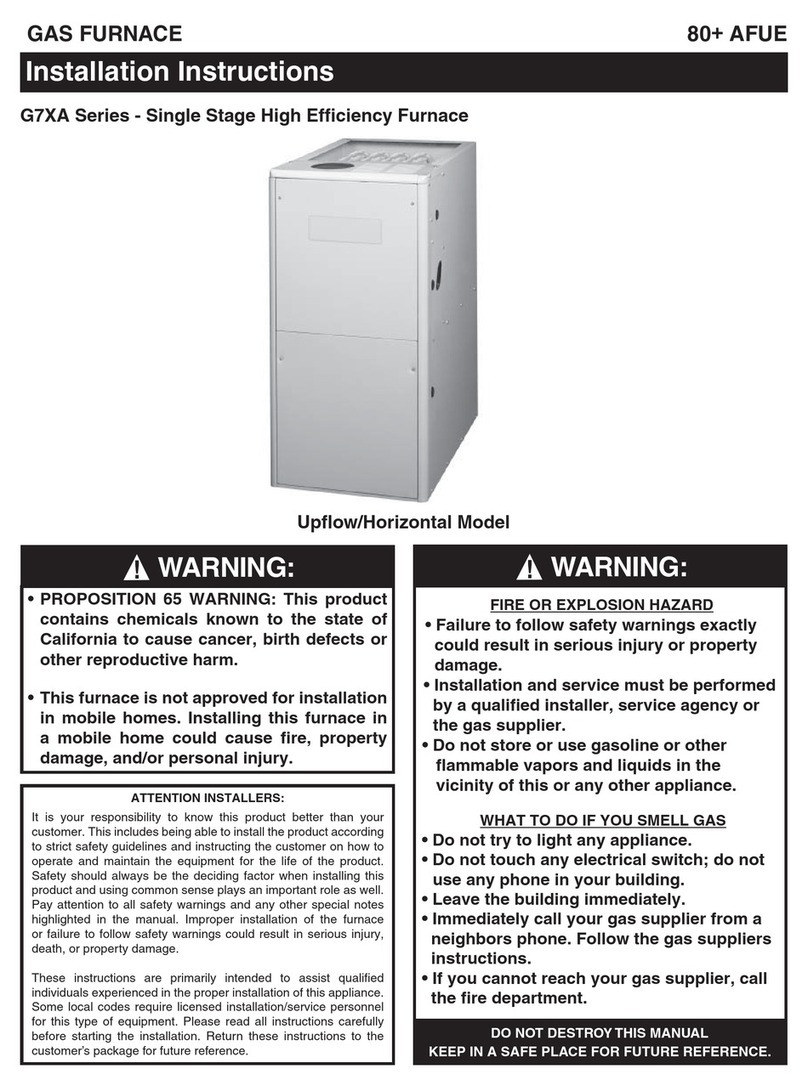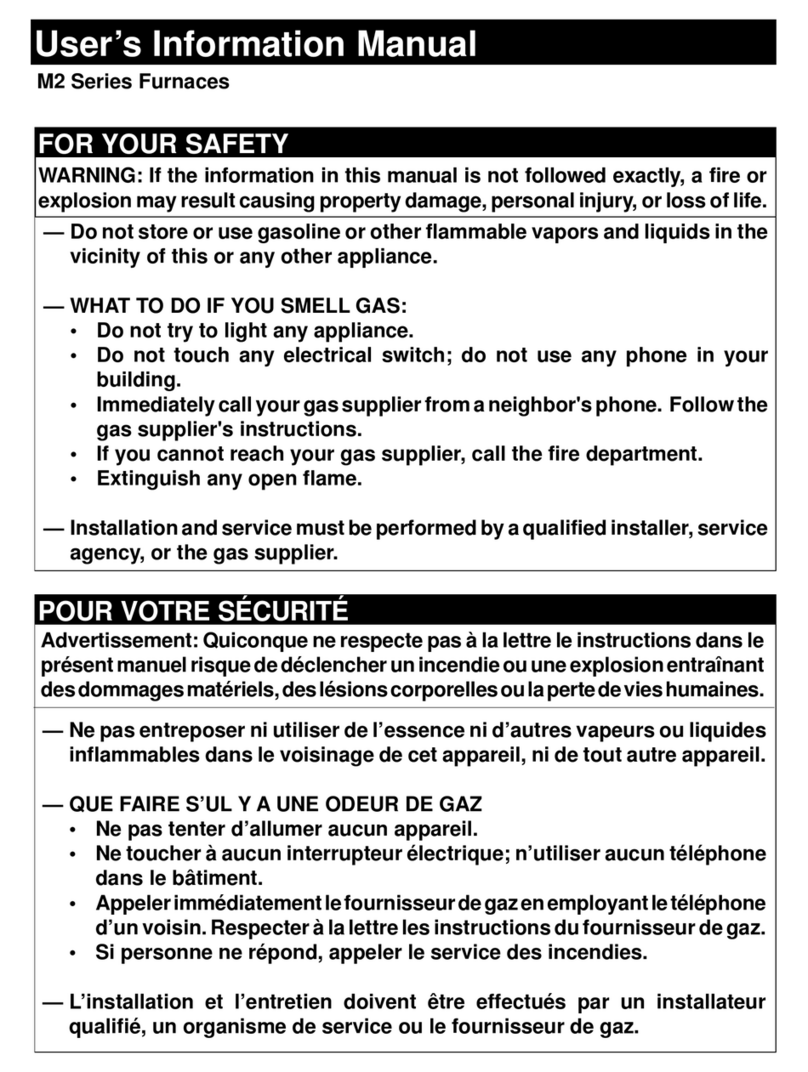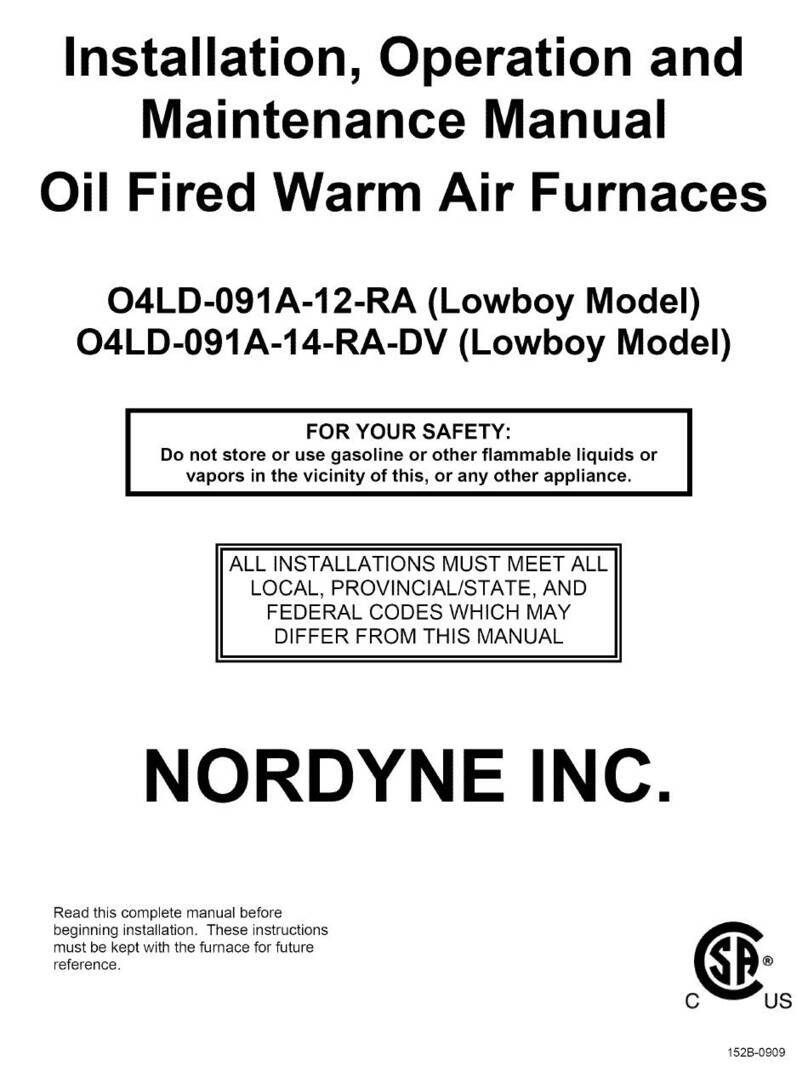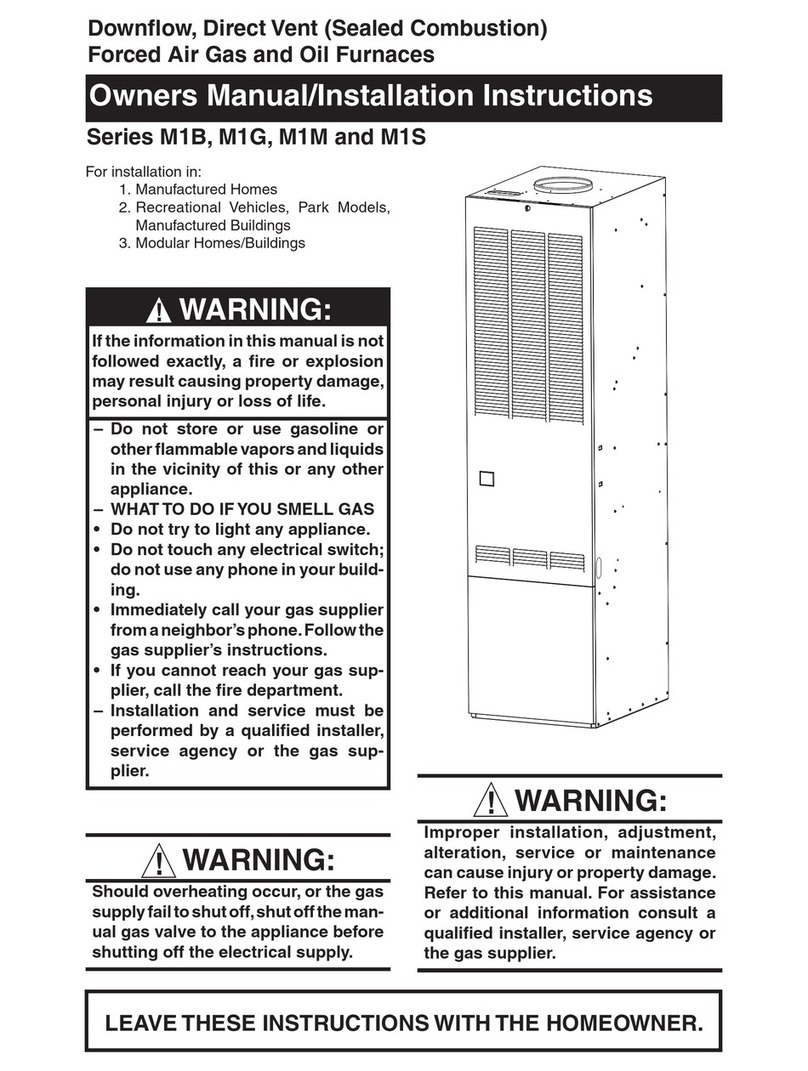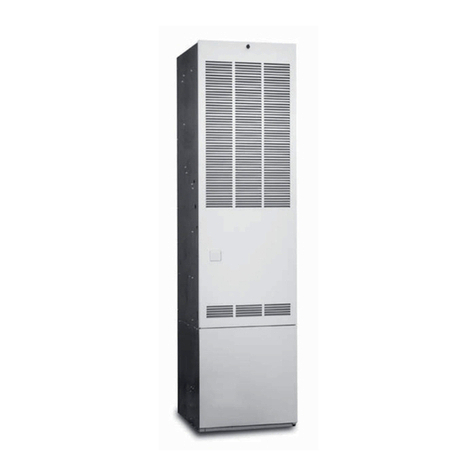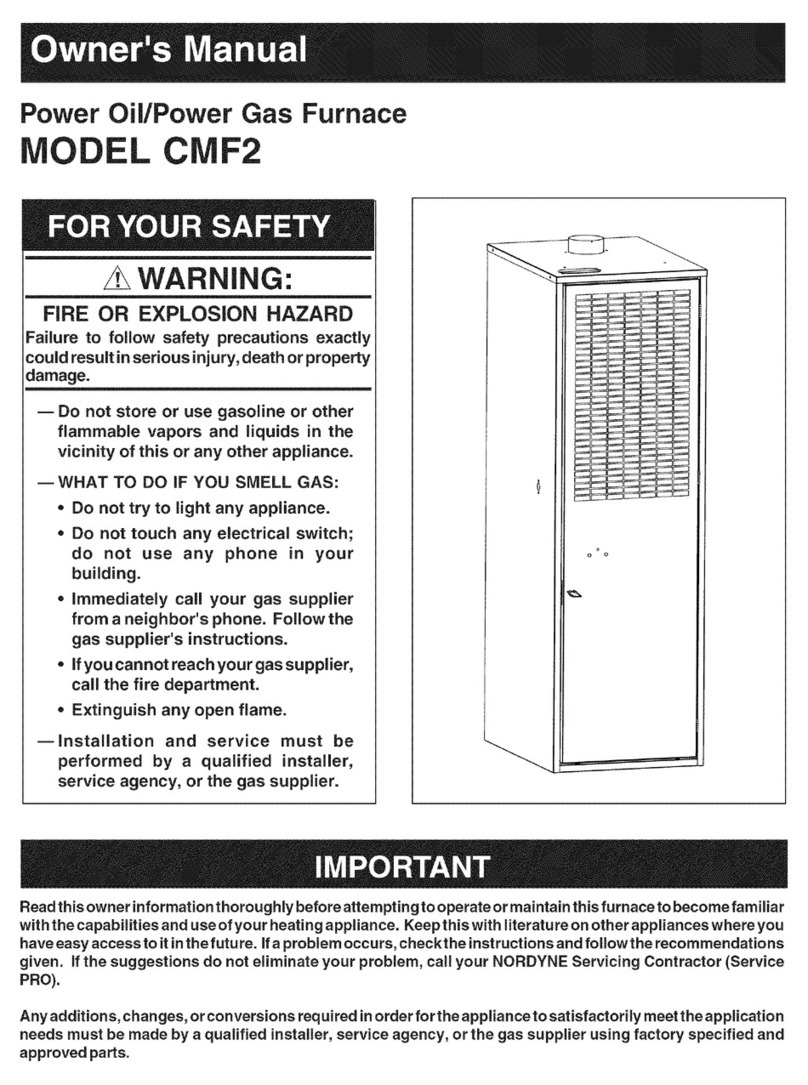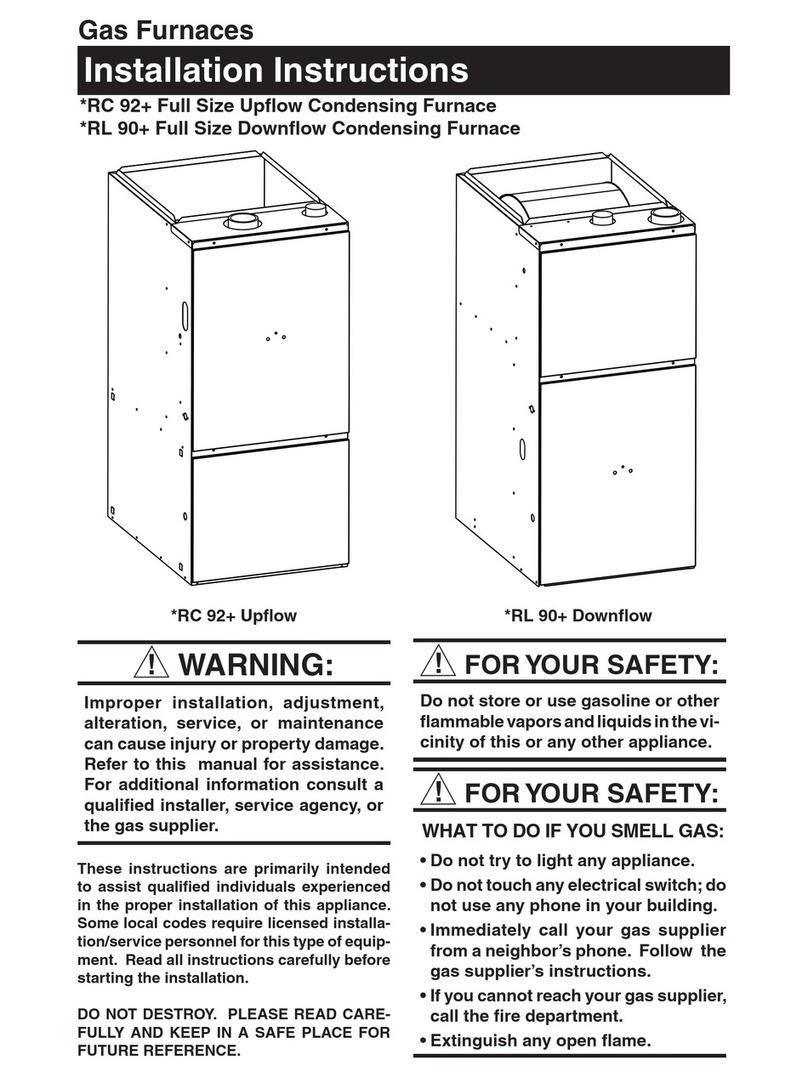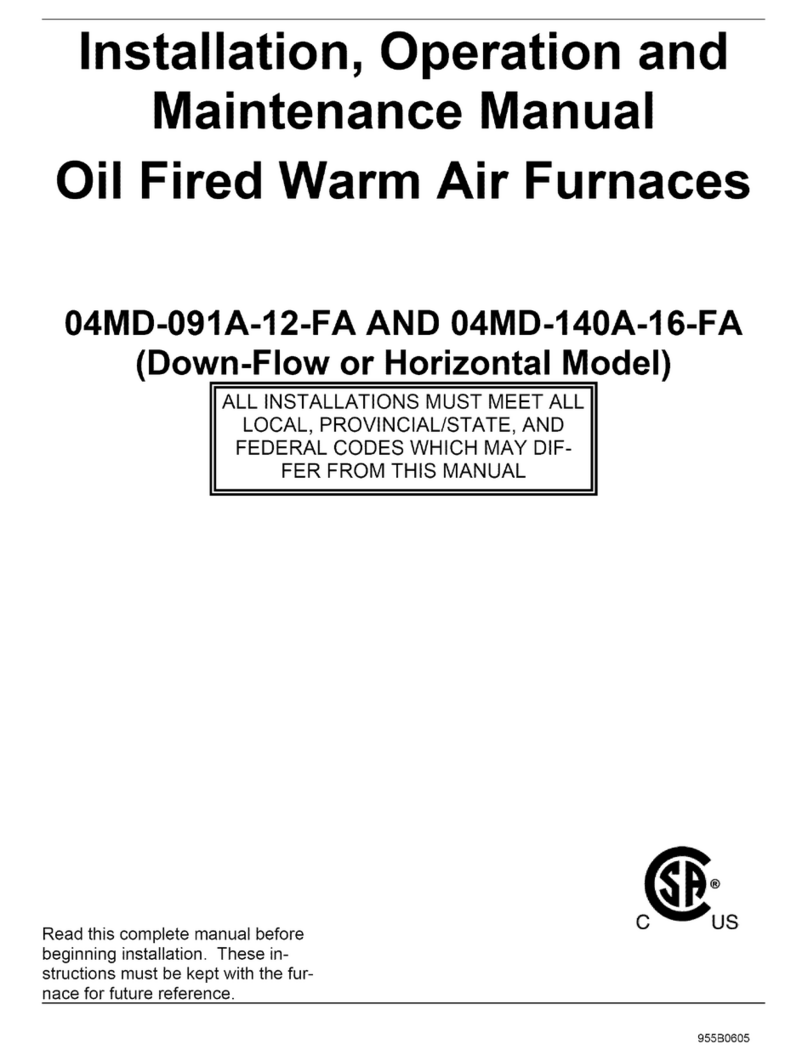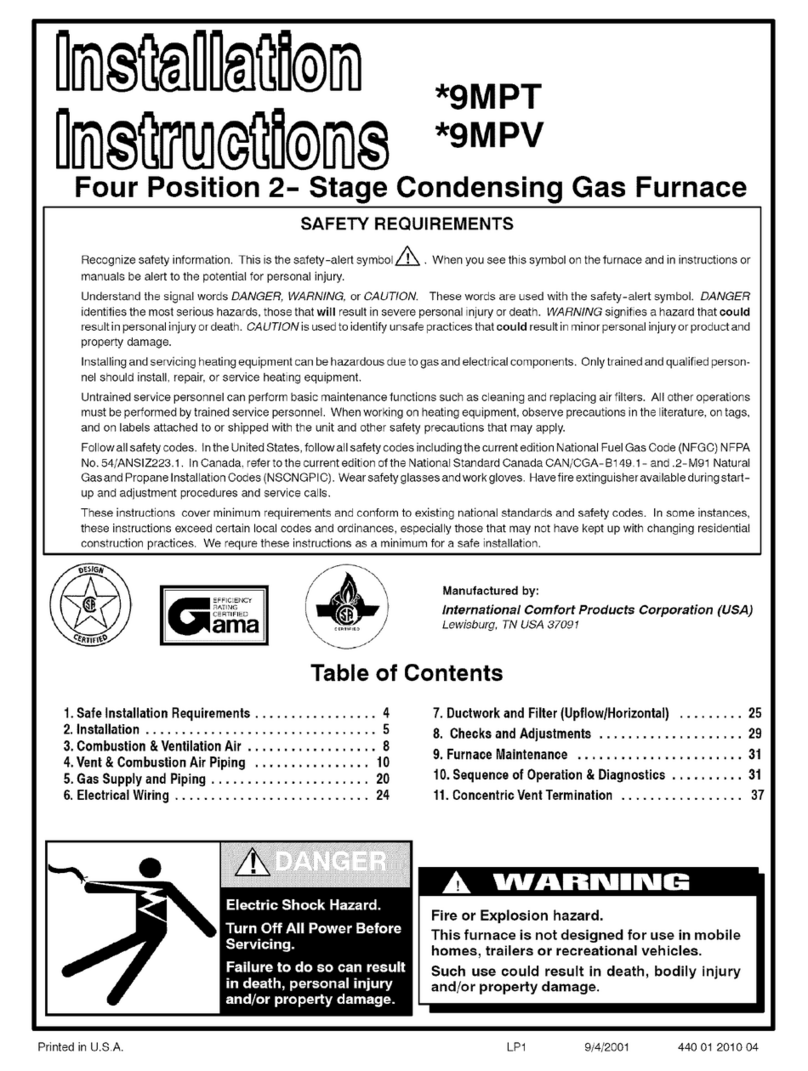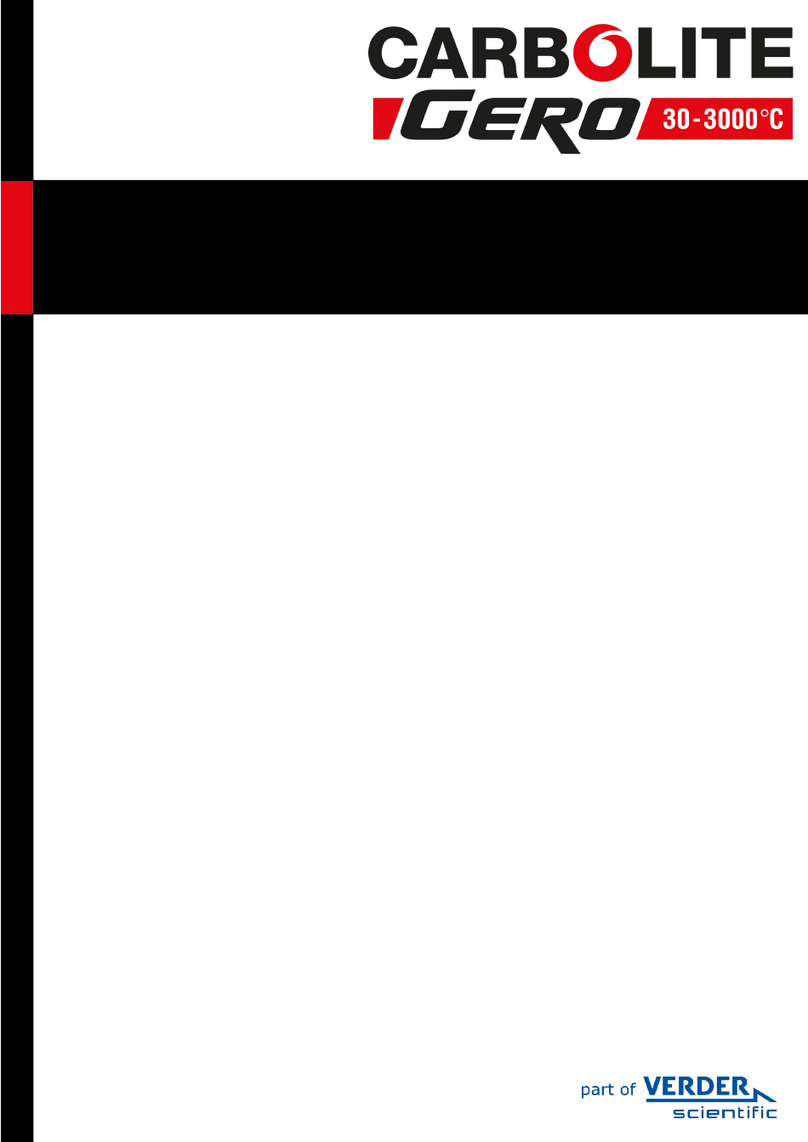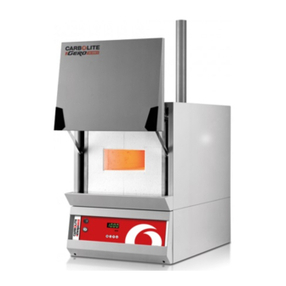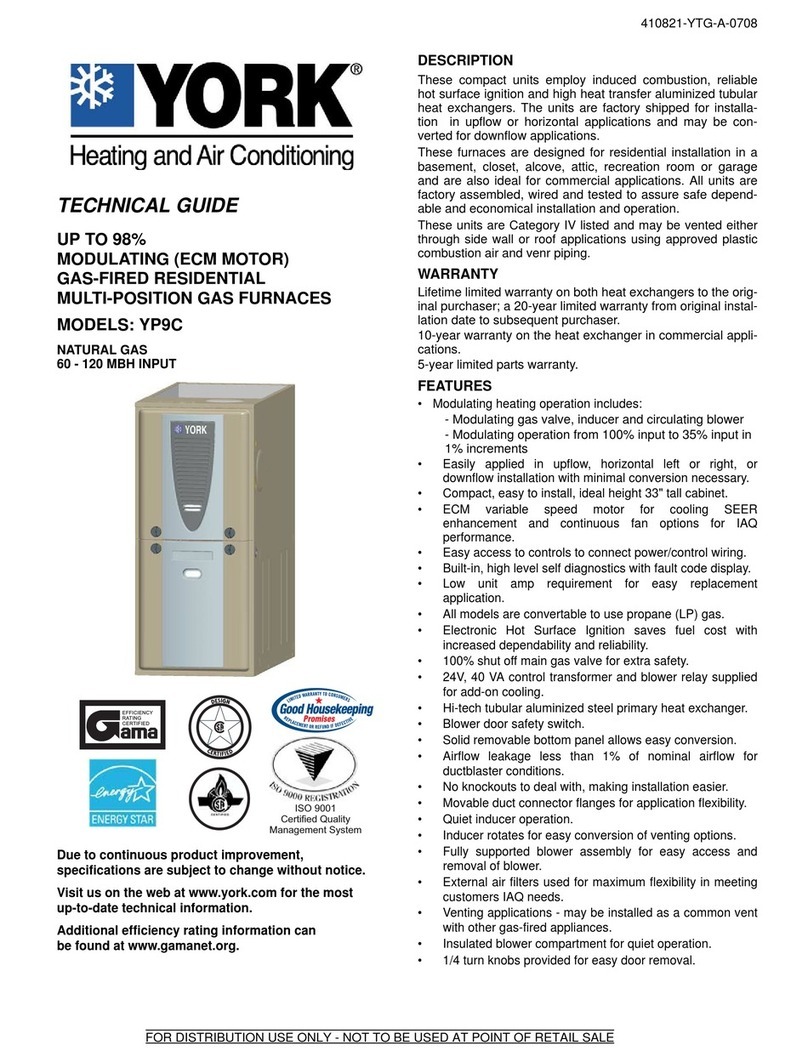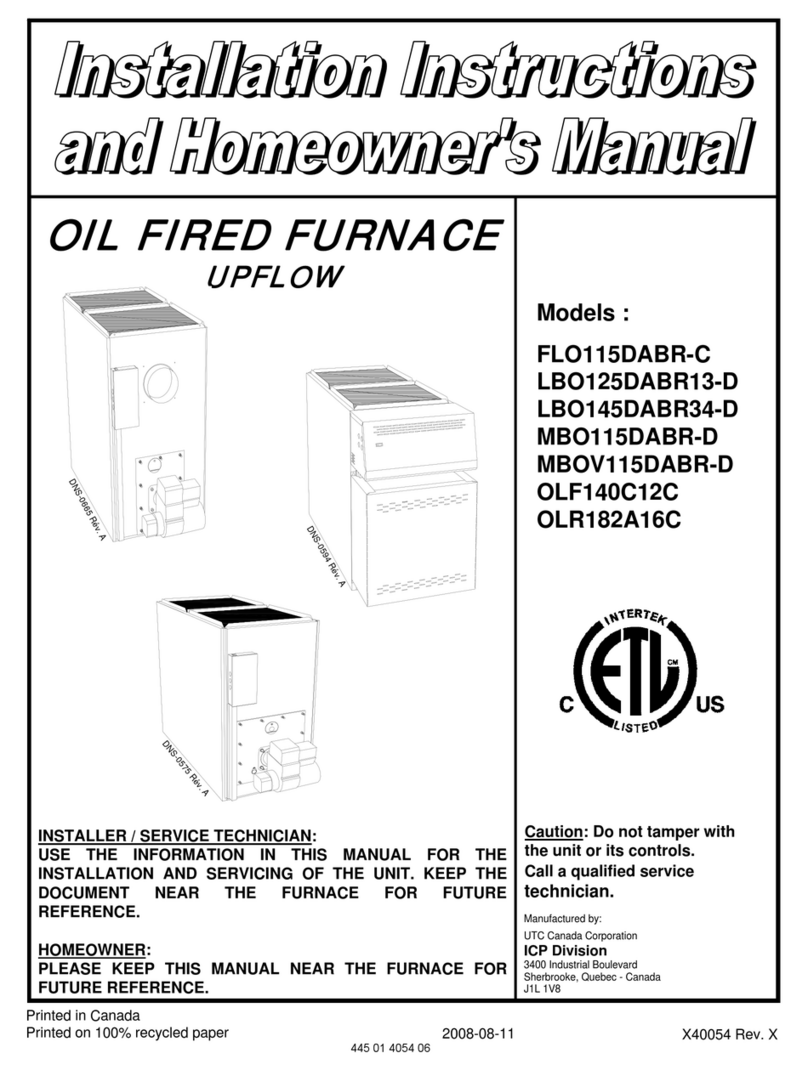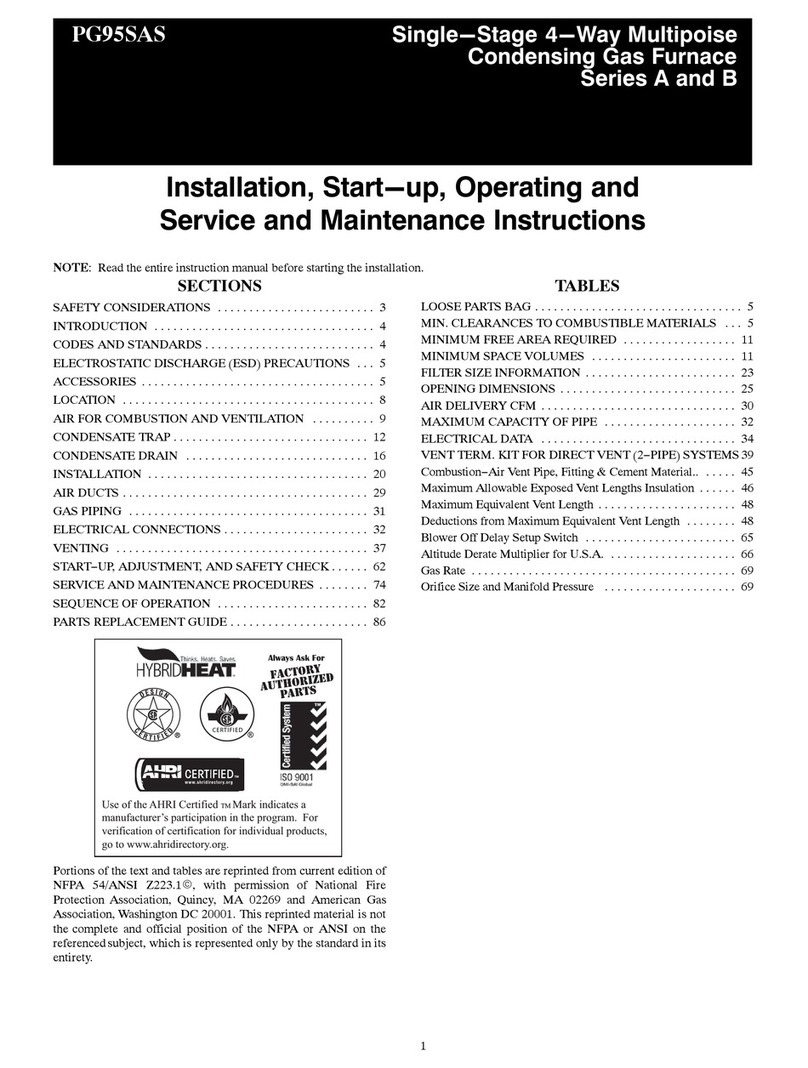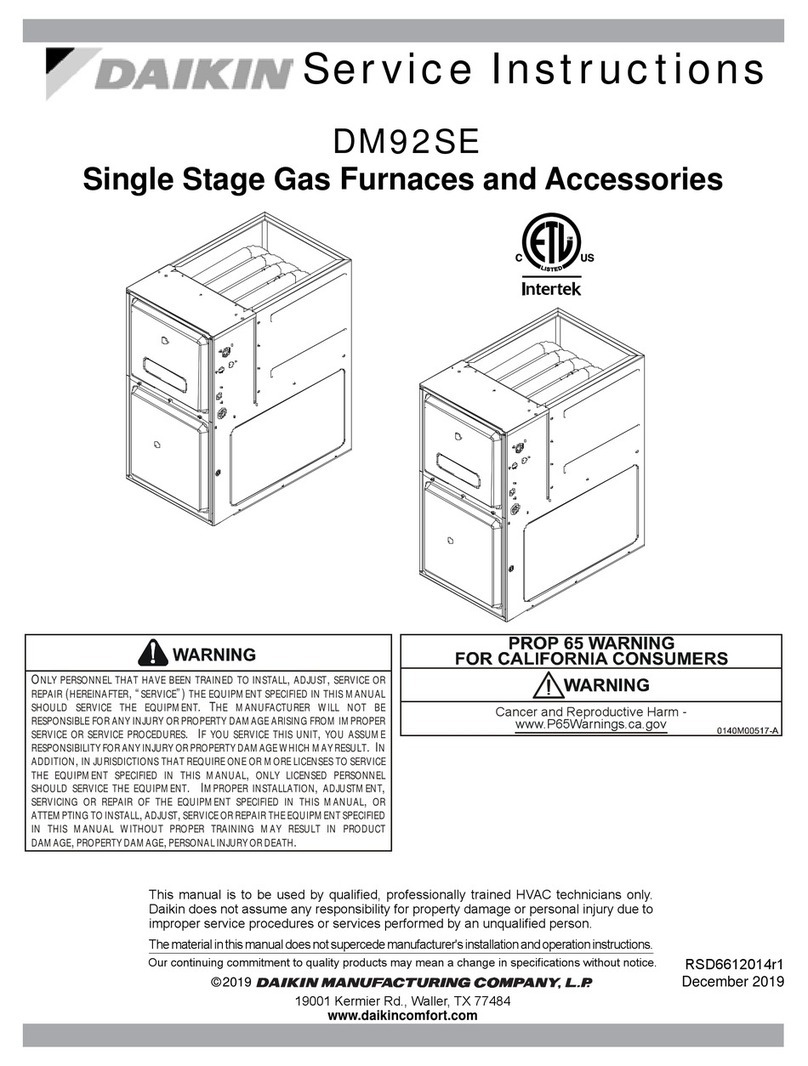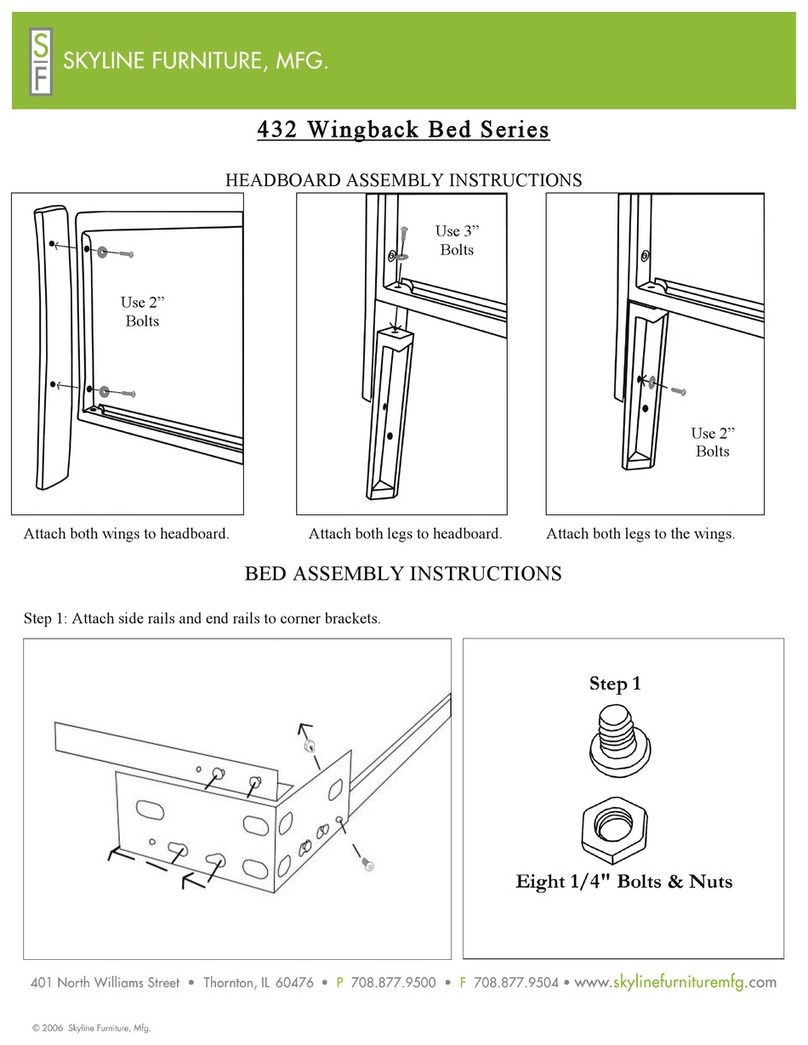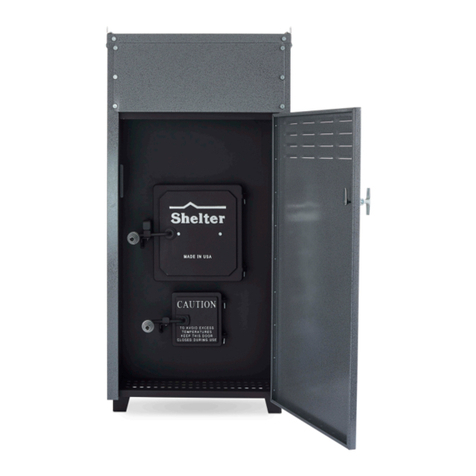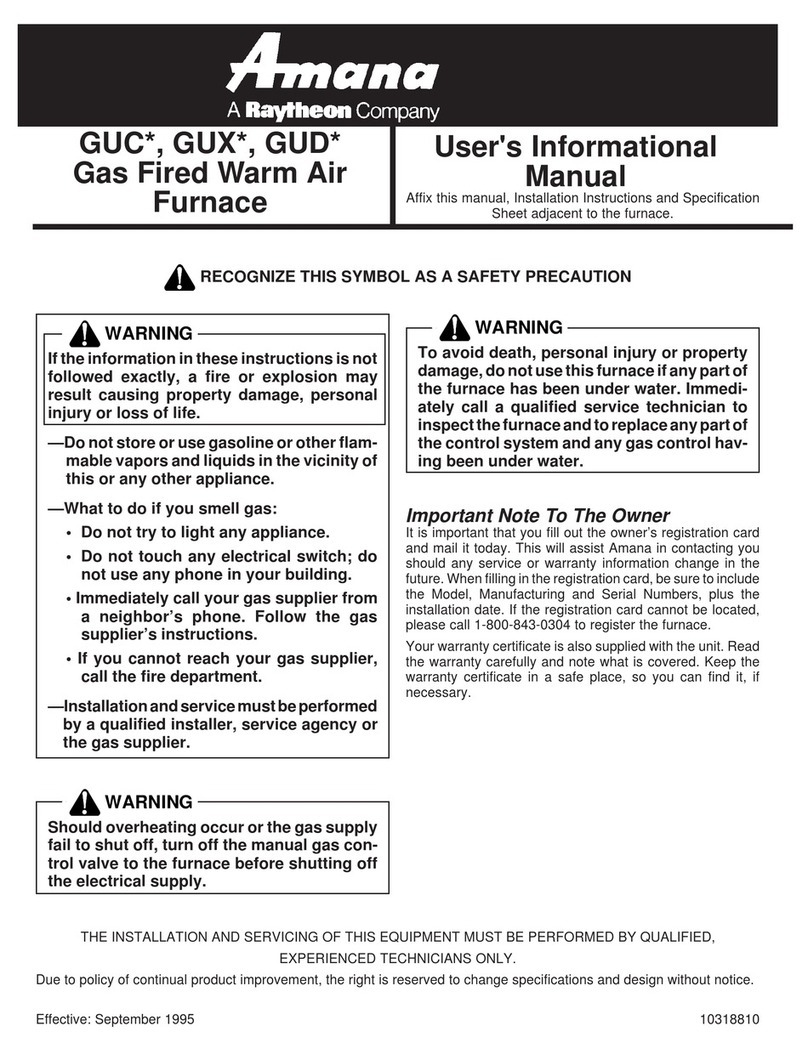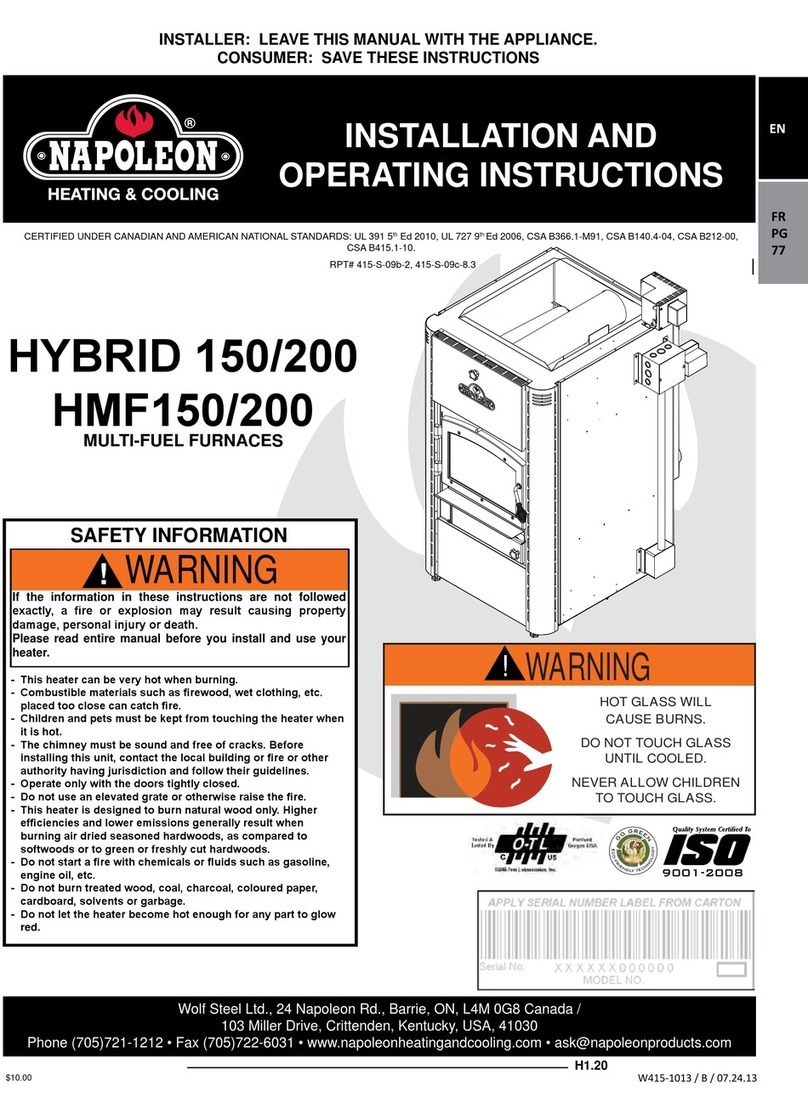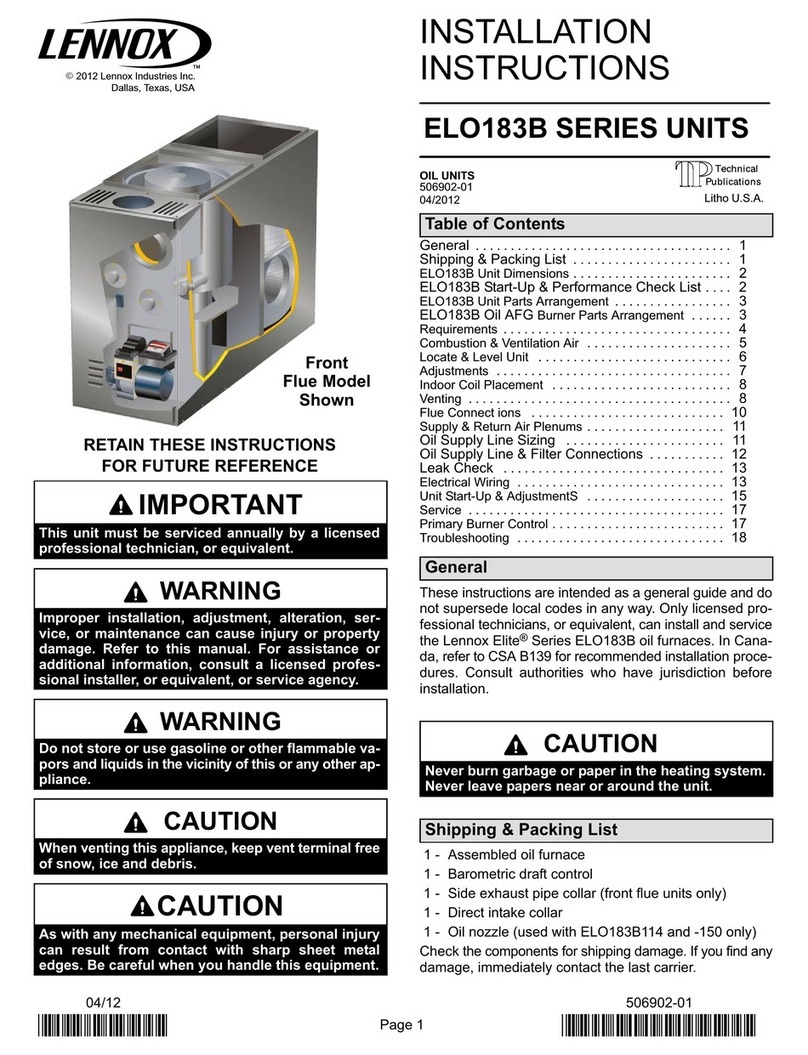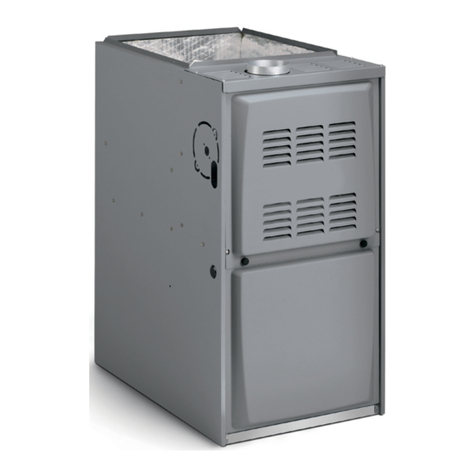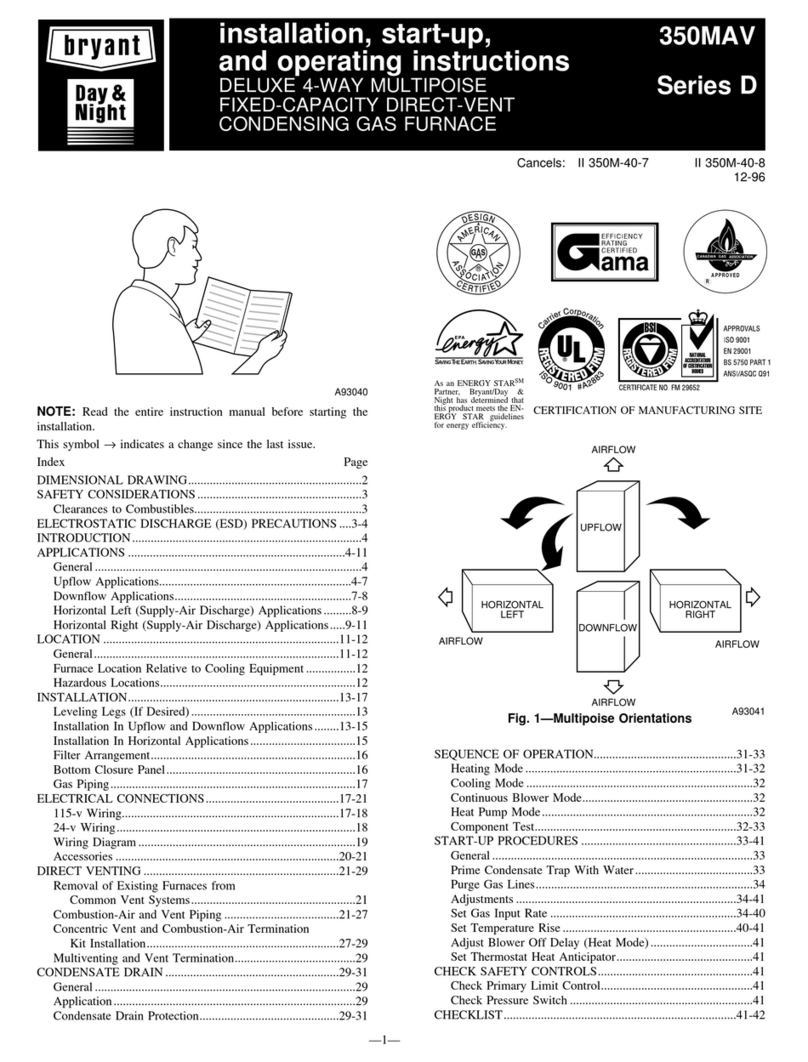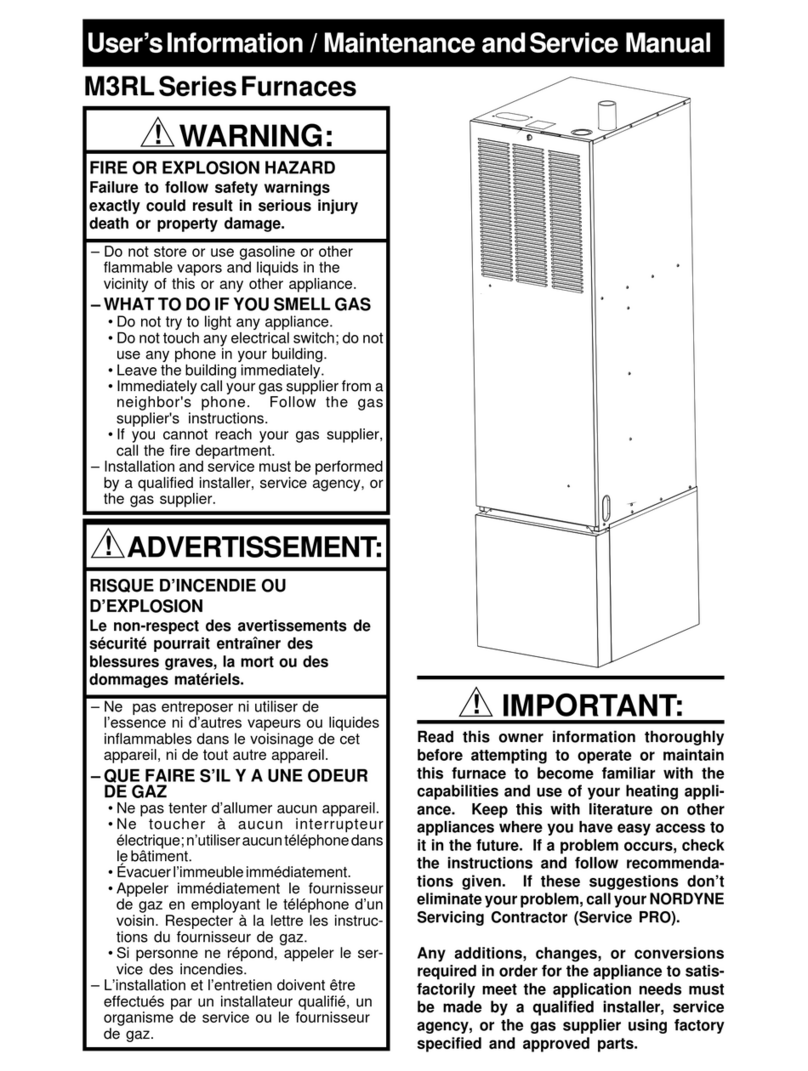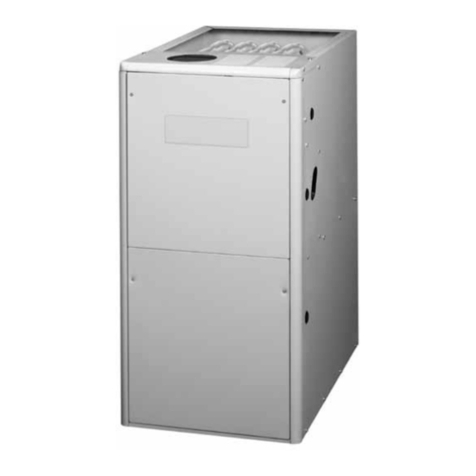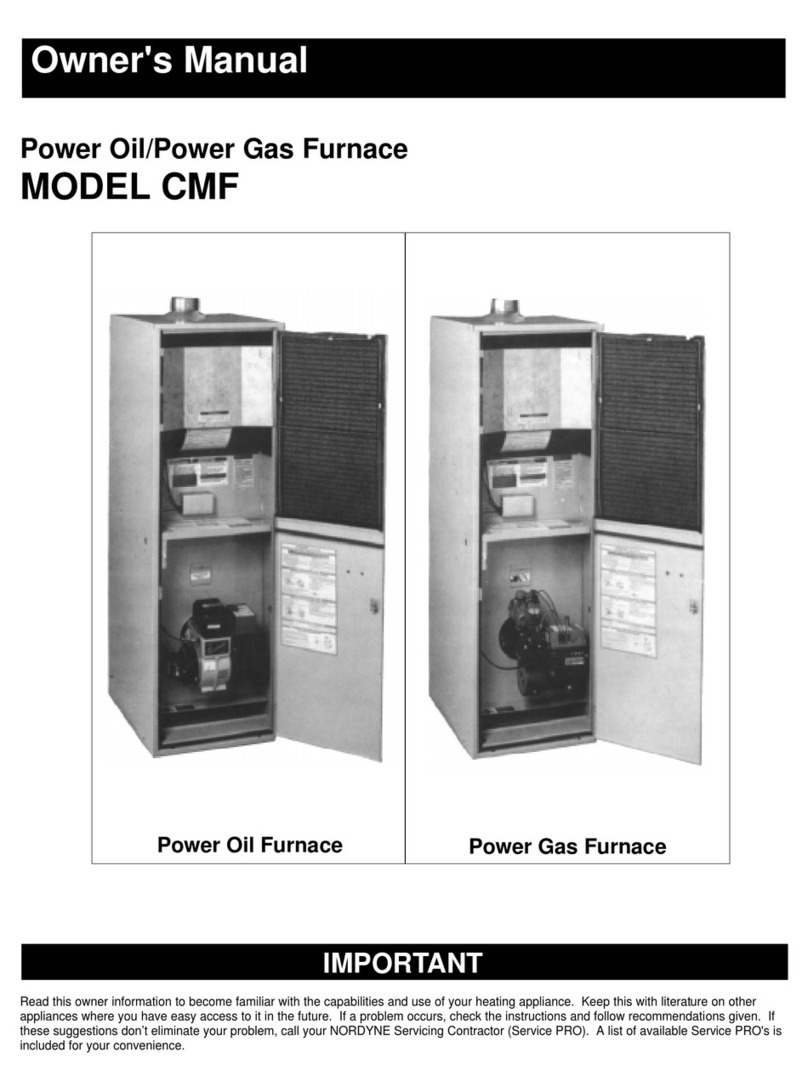
(serviceswitch)shouldbeclearlymarked,installedinan
easilyaccessibleareabetweenthefurnaceandfurnace
roomentry,andbelocatedinsucha mannerto reduce
thelikelihoodthatitwouldbemistakenasa lightswitch
orsimilardevice.
The power requirementfor the O4HD-091A-12-FB,
O4HD-091A-14-FA-DVandO4HD-091A-V-FAmodelsis:
120VAC,10, 60Hz.,12A.
Accessoriesrequiring120VACpowersourcessuchas
electronicair cleanersandhumidifiertransformersmay
be poweredfromthe electronicfan timerboardwhere
provisionshavebeenmadefor connections,butshould
havetheirowncontrols.Donotusethedirectdrivemotor
connectionsasapowersource,sincethereisahighrisk
ofdamagingtheaccessoriesbyexposuretohighvoltage
fromthe auto-generatingwindingsof the directdrive
motor.
Thermostatwiring connectionsand air conditioning
contactorlow voltageconnectionsare shownin the
wiringdiagramsin AppendixB. Somemicro-electronic
thermostatsrequireadditionalcontrolsandwiring.Refer
tothethermostatmanufacturer'sinstructions.
Thethermostatshouldbe locatedapproximately5 feet
abovethefloor,on an insidewallwherethereisgood
naturalair circulation,andwherethethermostatwillbe
exposedto averageroomtemperatures.Avoidlocations
wherethethermostatwillbeexposedtocolddrafts,heat
fromnearbylampsandappliances,exposuretosunlight,
heatfrominsidewallstacks,etc.
Thethermostatheatanticipatorshouldbeadjustedtothe
amperagedraw of the heating control circuit as
measuredatthe"R"and"W"terminalsofthethermostat.
Toreducetheriskof damagingtheheatanticipator,do
notmeasurethiscurrentwiththethermostatconnected
to thecircuit.Measuretheamperagebyconnectingan
ammeterbetweenthetwowiresthatwillconnecttothe
thermostat"R"and"W"terminals.
11. HUMIDIFIER
A humidifier is an optional accessory available through
most heating supplies outlets. Installation should be
carried out in accordance with the humidifier
manufacturer's installation instructions. Water or water
droplets from the humidifier should not be allowed to
come into contact with the furnace heat exchanger. Do
not use direct drive motor connections as a source of
power for 120 VAC humidifiers and humidifier
transformers.
12. PIPING INSTALLATION
The entire fuel system should be installed in accordance
with the requirement of CAN/CSA B-139, and local
regulations. Use only an approved fuel oil tanks piping,
fittings and oil filter.
In the United States the installation must be in
accordance with NFPA No. 31 and local codes and
authorities.
Install the oil filter as close to the burner as possible.
For further details of the oil supply tank and piping
requirements, please refer to the instructions and
illustrations in the oil burner and oil pump
instructions shipped with the furnace.
13. OIL FILTER
All fuel systems should include an oil filter between
the fuel oil storage tank and the oil burner. When
using an oil burner nozzle smaller than 0.65 U.S.
Gallons Per Hour, install an additional 7 to 10 micron
filter as close as possible to the oil burner.
14. OIL BURNER NOZZLES
The O4HD-091A-12-FB, O4HD-091A-14-FA-DV and
O4HD-091A-V-FA are certified for multiple firing
rates, ranging from 59,000 to 86,000 Btu/h. By
manipulating the oil burner nozzle, flame retention
head, static plate and temperature rise; the furnace
may be fired at an ideal rate for a wide range of
structures. Refer to Table A-l, and the furnace
rating plate to determine the proper combinations.
15. OIL BURNER ADJUSTMENT
The burner air supply is adjusted to maintain the fuel
to air ratio to obtain ideal combustion conditions. A
lack of air causes "soft" and "sooty" flames, resulting
in soot build-up throughout the heat exchanger
passages. Excess combustion air causes a bright
roaring fire and high stack temperatures resulting in
poor fuel efficiency. The O4HD-091A-12-FB, O4HD-
091A-14-FA-DV and O4HD-091A-V-FA furnaces
operate most efficiently with a No. 1 smoke spot on
the Bacharach Scale. This is not necessarily the
optimum setting; however, because dust will
inevitably build up on the air moving components of
the oil burner assembly. This will result in decreased
air supply with the potential result of soot building up
in the flue gas passageways of the heat exchanger.
Soot behaves as an insulator and impairs good heat
transfer. Stack temperature will increase, and the
overall efficiency will decrease. As a means of
avoiding this problem, it is advisable to adjust the air
supply to provide no more than a trace smoke spot
on the Bacharach Scale.
See the Venting Instructions included in the Vent
Kits for set-up details for sidewall vented furnaces.
NOTE: SIDEWALL VENTED MODELS
SHOULD BE SET UP TO DELIVER ZERO (0)
SMOKE.




















